Curves play a very important role in highway and railway construction. Different types of curves are provided in highways or railways for different purposes. So it is very important for a civil engineer to know where to introduce a curve and how to introduce it. The design and construction method of the curve part is different from a straight part.
What Are Curves in Advance Surveying?
Curves in advance surveying refer to non-linear segments incorporated into linear alignments to accommodate changes in direction, elevation, or both.
Curves are the geometrical arcs, which join two intersecting directions or two intersecting gradients with a gradual change. These curves allow for smoother transitions between straight sections, minimizing abrupt changes that could compromise safety or efficiency.
Factors considered for designing a Curved path
In the design of a curved part of a highway, some new factors have to be considered which are not considered in straight part.
- The speed of the vehicle must be reduced in curved parts.
- The centrifugal effects of the moving vehicle are balanced by providing superelevation.
- The extra width is provided in the curved part of the road.
- The radius of the curve is also an important factor. If the vehicle is moving in the curved path of a small radius at a high speed, a high amount of centrifugal force acts on the vehicle. To withstand high centrifugal force, a large superelevation has to be provided. large super elevation increases the chance of overturning. Now if we provide a higher radius, all of these problems are solved.
Why curves are provided in highway or railway projects?
The different types of curves are introduced in the highway or railway project whenever two straight directions or two gradients intersect each other at some angle. The curves are introduced in that situation to negotiate the change in direction or in gradient gradually. There are various benefits of providing different types of curves in highway or railway alignment.
- The vehicles can change their direction at the intersection safely through the curve.
- The curve provides better sight distance at the intersection. Hence it reduces the chances of accidents.
- Due to the gradual change of the alignments in the intersections, passenger comforts are not hampered.
- Curves are provided for laying road or rail according to the topography.
- By providing curves, construction of the road on costly land, important structures, religious places, etc are avoided.
- For using an existing bridge or road, curves are provided.
Types of curves in surveying
The types of curves are broadly classified into two categories:
- Horizontal curves
- Vertical curves
Horizontal curves
A horizontal curve is a curve that is provided in the horizontal plane for joining two intersecting alignments. A horizontal curve is used to provide a gradual change in the direction of the centerline of the road. The minimum radius of the horizontal curve depends upon the permissible design speed of the highway.
Horizontal curves are further classified into 5 types of curves :
- Simple circular curve
- Compound curve
- Reverse curve
- Transition curve
- Broken-back curve
Simple circular curve
A simple circular curve is a curve that consists of a single arc of uniform radius for connecting two tangents. These types of curves are generally provided where two alignments can be joined with a large radius. These types of curves are suitable for slow-moving vehicles.

Compound curve
The compound curve consists of two or more arcs with different radii which turn in the same direction. The arcs of the compound curve lie on the same side of their common tangent. Similarly, the centers of those arcs lie on the same side of their common tangent.
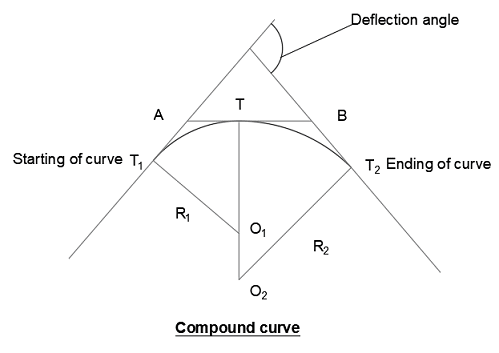
Reverse curve
The reverse curve consists of two simple circular curves with the same or different radius that bends in opposite directions. The centers of those two simple circular types of curves will lie on the opposite side of the curve. Those two simple curves have a common tangent. The other name of this curve is the ogee curve or serpent curve. These types of curves are provided for connecting two parallel directions.
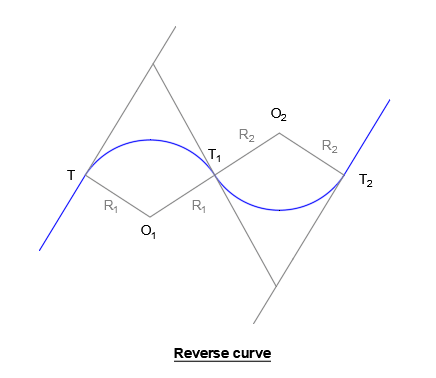
Transition curve
A transition curve is a curve having a variable radius value. The radius of this type of curve gradually changes from a finite value to an infinite value or vice versa. This curve is also known as the easement curve.
Functions of Transition curve
- A transition curve is generally used to join a straight and a simple circular curve or two simple circular curves.
- To minimize superelevation and the discomfort of passengers, these types of curves are generally provided on both sides of circular curves.
- For introducing a gradual change from the tangent point to the circular curve and vice versa.
- To introduce the designed super elevation gradually at the starting of the curve.
- To enable the introduction of the extra widening of the road at the starting point of the curve.
Types of Transition curve
The transition curves are further classified into three types of curves:
- Bernoulli’s lemniscate curve
- Cubic spiral or clothoid or Euler’s spiral
- Cubic- parabola or Froude’s curve
Cubic spiral and Cubic parabola
These are not ideal transition curves. The method of laying out these curves is very easy. Cubic spiral and cubic parabola are extensively used in railways.
Clothoid
Clothoid is an ideal transition curve. The radius of the curvature is inversely proportional to the distance from the starting point of the curve.
Bernoulli’s lemniscate curve
Lemniscate curve fulfills the conditions to be an ideal transition curve. The rate of change of curvature of this curve is gradual. Lemniscate curves are extensively used in highways.
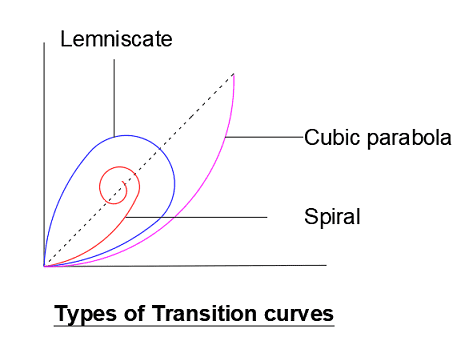
Ideal Transition curve
A curve is said to be an ideal transition curve if the rate of change of curvature is gradual.
Clothoid and Bernoulli’s lemniscate curve fulfills this requirement. Hence these two are known as ideal transition curves.
Broken-back curve
A broken back curve consists of two circular curves with the same or different radius joined with a short common tangent. In broken back curves the centre of those circular arcs lies on the same side. In earlier days these curves are used for railroad traffic. But as this curve is not suitable for high-speed traffic, nowadays they are not used.
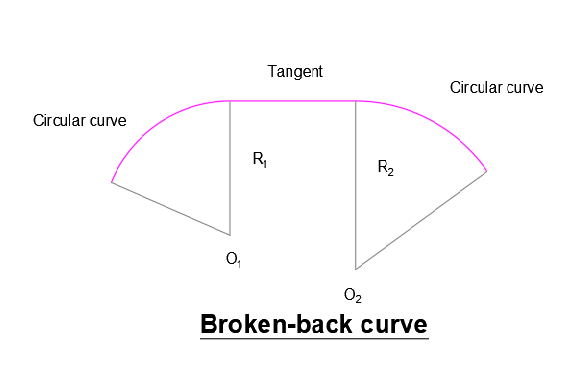
Vertical curves
Vertical curves are provided at the intersections of different grades to connect them through a gradual change in gradients. Vertical curves round off the sharp angle of the intersecting gradients. Vertical curves also minimize the gradients to provide a minimum sight distance.
The shape of the vertical curves may be circular or parabolic. The parabolic shape is preferred because of the following reason.
- Longer sight distance because of the flatness at the top of the parabolic shape. Hence it reduces the possibility of accidents.
- Parabolic shapes provide the best riding qualities because of the uniform rate of change of grade.
The vertical curves are further classified into two types of curves
- Sag curve or valley curve
- Summit curve
Sag curve or valley curve
Sag curves are the vertical curves having their convexity downwards. Sag curves are generally introduced when
- A negative grade meets a level stretch.
- A negative grade meets a milder negative grade.
- A negative grade meets a positive grade.
- A positive grade meets a steeper positive grade.

Summit curve
Summit curves are the vertical curves having their convexity upwards. Summit curves are generally introduced when
- A positive grade meets a level stretch.
- A positive grade meets a milder positive grade.
- A positive grade meets a negative grade.
- A negative grade meets a steeper negative grade.
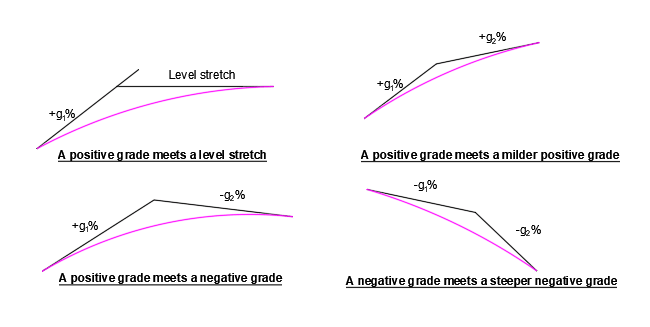
What Are the Applications of Different Curve Types?
Circular Curves:
- Road Construction: Circular curves are extensively used in road design to accommodate vehicle turning radii and ensure smooth traffic flow.
- Railway Tracks: Curved sections in railway tracks allow trains to negotiate bends safely and efficiently.
Spiral Curves:
- Highways: Spiral curves are employed in highway design to transition smoothly between tangent sections and circular curves, reducing driver discomfort and enhancing safety.
- Canal Construction: Spiral curves facilitate gradual transitions in canal alignments, minimizing erosion and sedimentation.
Parabolic Curves:
- Bridge Approaches: Parabolic curves are often used in bridge approach design to provide gentle transitions between the bridge deck and the roadway, ensuring vehicle stability and ride comfort.
- Airport Runways: Parabolic curves in airport runway design help aircraft achieve optimal takeoff and landing trajectories, enhancing operational efficiency and safety.
Do’s & Don’ts
Do:
- Conduct thorough site reconnaissance to identify terrain features and potential curve locations.
- Use advanced surveying equipment and software to accurately measure curve parameters.
- Consider safety factors and design standards when selecting curve types and alignments.
- Regularly monitor construction progress and quality control to ensure curve accuracy and integrity.
Don’t:
- Neglect to verify survey data and check for errors before finalizing curve designs.
- Overlook the importance of stakeholder consultations and community feedback in curve planning.
- Rely solely on visual inspections for curve identification, as this may lead to inaccuracies and oversights.
- Underestimate the significance of proper curve maintenance and signage in ensuring road safety.
Frequently Asked Questions (FAQs)
1. What factors influence the selection of curve types in advance surveying?
- The terrain, design speed, traffic volume, and design standards are key factors influencing curve selection.
2. How do engineers calculate the parameters of circular curves?
- Circular curves’ parameters, including radius and central angle, are calculated using geometric formulas or specialized software.
3. What are the advantages of using compound curves?
- Compound curves offer greater flexibility in alignment design, allowing engineers to navigate challenging terrain or incorporate aesthetic features.
4. Why are reverse curves essential for highway safety?
- Reverse curves provide clear visual cues to drivers, alerting them to upcoming changes in direction and reducing the risk of accidents.
5. How do engineers mitigate the effects of centrifugal force on vehicles in curves?
- Engineers design curves with appropriate superelevation or banking to counteract centrifugal force, ensuring vehicle stability and safety.
6. What are the drawbacks of using sharp curves in transportation projects?
- Sharp curves increase the risk of vehicle accidents, induce discomfort for passengers, and require more frequent maintenance due to higher wear and tear.
7. What role do spiral curves play in railway engineering?
- Spiral curves facilitate smooth transitions between straight tracks and curves, reducing wear on rolling stock and track infrastructure.
8. How do clothoid curves differ from traditional circular curves?
- Clothoid curves feature variable curvature along their length, offering smoother transitions and enhanced comfort for passengers compared to circular curves.
9. What challenges do engineers face when designing parabolic curves?
- Engineers must ensure precise control of vertical alignment to maintain structural integrity and hydraulic efficiency in projects involving parabolic curves.
10. How can advance surveying techniques improve curve design and construction?
- Advanced surveying tools, such as GPS and LiDAR technology, enable engineers to accurately assess terrain conditions and optimize curve design for safety and efficiency.
Conclusion
Understanding the types of curves in advance surveying is essential for engineers involved in infrastructure projects. From circular and compound curves to spiral and clothoid curves, each type offers unique advantages in accommodating changes in alignment, elevation, and curvature. By selecting the most suitable curve type and incorporating advanced surveying techniques, engineers can enhance safety, efficiency, and aesthetics in transportation and construction endeavors.

